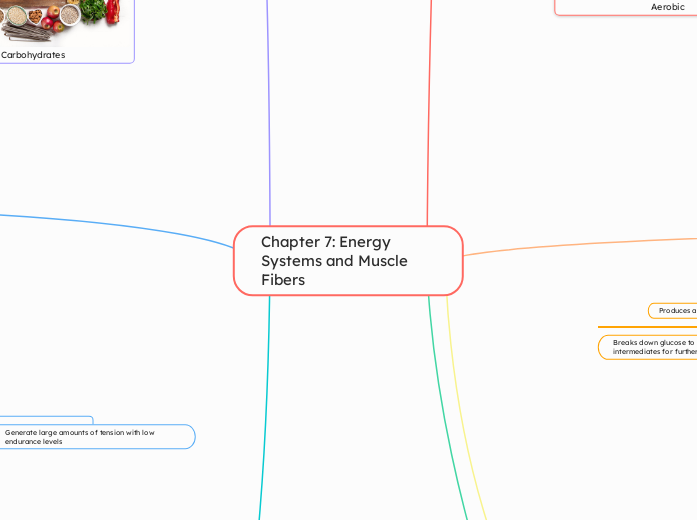af Liam Duclos 1 år siden
140
Chapter 7: Energy Systems and Muscle Fibers

af Liam Duclos 1 år siden
140

Mere som dette
Generate energy slowly
Mainly depend on anaerobic processes
Slow-oxidative
Simple vs Complex carbohydrates
Complex Carbs: Starches and fibers found in foods like grains, vegetables, and legumes
Simple Carbs: Rapidly digested sugars found in foods like fruits, candies, and soft drinks
Dietary guidelines suggest consuming a majority of calories from carbohydrates, mainly from whole food sources
Some amino acids are essential, meaning they must be obtained from the diet
20 different amino acids, each with a unique side chain
linked together by peptide bonds
Essential for growth and repair
Contain large quantities of stored energy
Must be consumed with food
Found is muscle cells and adipose tissue
Glycerol
Fatty acids
After use, creatine phosphate can be regenerated during rest periods when ATP demand is lower
Stored primarily in skeletal muscle tissue, with higher concentrations in fast-twitch muscle fibers used for explosive movements
Creatine phosphate stores are quickly depleted during high-intensity activities and are not sustainable for prolonged endurance efforts
Acts as a rapid and readily available energy reserve for muscle cells during short bursts of intense activity
During prolonged exercise, muscle glycogen stores can become depleted, leading to fatigue
Glycogen stores are replenished through dietary carbohydrates, particularly after exercise or periods of fasting
Glycogen is broken down into glucose through glycogenolysis when the body requires energy
It is a polysaccharide, meaning it consists of multiple glucose molecules linked together
Found in the liver and other muscles
Liver glycogen helps maintain blood glucose levels between meals and during fasting periods
Muscle glycogen provides energy for muscle contraction during exercise
Belongs to the carbohydrate group, abundant in many foods like fruits, vegetables, and grains
During exercise, muscles rely on glucose for energy, especially during high-intensity activities
Essential for brain function, as neurons rely primarily on glucose for energy
Energy source is glycogen, fats and proteins
2min and beyond duration
Fatigue resistant
Slow and complete breakdown of glucose
Long-distance swimming
Cross-country skiing
Marathon
Carbon dioxide and water are produced as waste products.
Produces 36 molecules of ATP
Consists of three main stages: glycolysis, the citric acid cycle (Krebs cycle), and oxidative phosphorylation (electron transport chain)
Cells break down glucose and other organic molecules to produce ATP
Provides a highly efficient way to extract energy from glucose molecules, maximizing ATP production
Cellular respiration produces a large amount of ATP, with oxidative phosphorylation contributing the majority of ATP production
Location of activity is the mitochondria
O2 required
Glucose as an energy source
15s-3min duration
Fast surge of power
HIIT circuit
Hockey shift
400m run
Lactic acid buildup causing a burning sensation in the muscles
Lactic acid is a byproduct
A net gain of 2 ATP molecules per glucose molecule.
Due to the accumulation of lactate and depletion of glycogen stores, the glycolytic system is not sustainable for prolonged periods of activity
Provides rapid but limited energy for short bursts of intense activity
Takes place in the cytoplasm of cells
Begins with the breakdown of glucose into pyruvate
10-15s duration
Fatigue quickly
Super quick surge of power
Shot put
Jump events
100m sprint
No by products
1-2 chemical reactions
1 molecule of ATP
Energy source is creatine phosphate
Takes place in the cytoplasm
02 not required